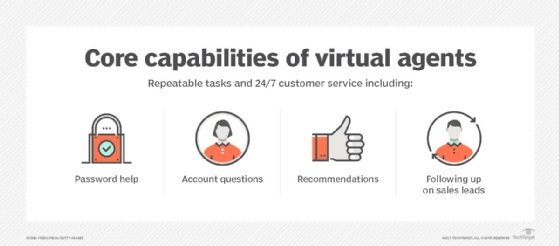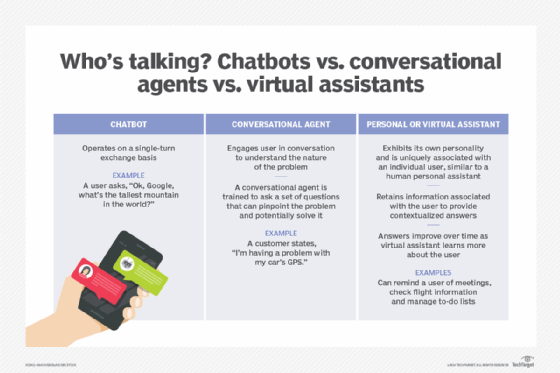What are virtual agents and how are they being used?
A virtual agent is an AI-powered software application or service that interacts with humans or other digital systems in a human-like manner, most often using natural language. Also called an intelligent virtual agent or conversational agent, it accepts human user input by speech or text, processes it using a set of rules or a machine learning (ML) model, and responds with human-like output.
A typical virtual agent has the following features:
- Natural language understanding and generation. Most virtual agents interact with human communication, both input and output. They can detect the user's intent, extract specific data items from the input, resolve ambiguities and dynamically generate meaningful output. Many can stylize their responses emotionally -- such as by being friendly and empathetic -- and some can keep track of context within a conversation.
- Contextual awareness. Tracking context empowers the agent to remember previous exchanges within a conversation, sometimes long-term, making the exchange a full dialogue. This can further enable the agent to track user goals and preferences and to adapt its answers based on previous states.
- Application programming interface (API) integration. Virtual agents are commonly designed to connect to data sources, giving them broad functionality in tasks such as payment processing, appointment creation and interaction with customer relationship management (CRM) systems.
- Personalization. Many virtual agents can make interactions with users feel individualized, learn their preferences and adapt to them. This enables them to produce personalized recommendations and content and adjust their style of interaction based on past behavior.
- Analytics. Virtual agents are data collection engines for ML. They harvest metrics from their interactions to provide insight into performance and user behavior for self-improvement, to identify trends and to continually optimize.
Many organizations use virtual agents to augment their customer service operations, as they can answer routine customer queries, fulfill standard requests and handle simple problems. Organizations often deploy virtual agents to handle initial customer interactions in their call centers or on their websites. Virtual agents help to facilitate customer self-service capabilities and provide immediate access to relevant information. Difficult customer questions or concerns are typically escalated to human representatives.
Some organizations use virtual agents internally to support their personnel in different ways. For instance, IT departments might implement virtual agents to provide basic help desk services, such as answering simple technical questions or resetting computer passwords. Organizations might also use virtual agents to guide personnel through work tasks and processes.

In some ways, virtual agents are similar to digital assistants -- also called virtual or AI assistants. Digital assistants are programs that understand natural language processing voice commands and can answer questions, fulfill people's needs or help them complete tasks.
Virtual agents vs. virtual assistants vs. chatbots
At a glance, virtual agent seems like just another name for a virtual assistant, or perhaps a chatbot. But there are significant differences between the three, and it's important to understand them.
At a high level, chatbots are far simpler than virtual agents. Their responses in user exchanges are completely scripted and rule-based, limiting their usefulness to answering frequently asked questions and performing other simple tasks. Virtual assistants are more intelligent and can assist with complex tasks like managing schedules and generating messages.
A virtual agent, however, can perform dynamic interactions -- rule-based but unscripted, capable of activities and tasks equal to low-level roles once filled by humans. These include customer service and support, more complex IT support and even enterprise automation, which includes contextual decision-making. A conversational agent is a type of virtual agent.
Digging down a little, chatbots are typically text-based, whereas virtual assistants can often handle both text and voice, and virtual agents can often do video and respond via avatar. Chatbots have minimal integration; assistants connect to personal apps, and agents integrate at the enterprise level. Chatbots don't learn; they must be manually updated. Assistants can learn user patterns, and agents continually learn through feedback.

How to create a virtual agent
Organizations that plan to implement a virtual agent, whether using a software platform or cloud service, need to invest the time and resources necessary to train the virtual agent to make accurate predictions. Training can include methods such as feeding the agent information from a knowledge base to help it learn.
The following is a step-by-step breakdown of how to put a virtual agent to work:
- Write its job description. What problem is the virtual agent solving? Who are its users? What does success look like, and how will it be measured? Answers to these questions will be the foundation of its design.
- Select a platform. There are many virtual agent platforms, including Amazon Lex, Google Dialogflow, IBM Watson Assistant, Microsoft Copilot Studio and Zendesk AI. Compare the core capabilities and intended use cases to choose the platform that fits best.
- Design the agent's conversation. This step has its own steps: identify what the user wants, define the data items involved, map the dialogs to establish how they should progress, and anticipate possible points of error or misunderstanding. Drag-and-drop conversation-building tools are available for this process.
- Integrate the agent with the necessary data sources. The virtual agent won't just chat, it will get things done. This can require connections to IT systems, databases, APIs and CRM systems.
- Test it and train it. Validate the agent's functionality and accuracy with sample dialogs, then run pilot deployments with small groups of user testers. Collect feedback and adjust as necessary.
- Deploy the agent across channels. These can include the company website, a mobile app, messaging apps or social media.
- Monitor the agent's performance. Optimize it as needed, tracking usage, performance, the escalation rate -- or percentage of interactions handed off to humans -- user satisfaction with interactions, average handling time and the cost per interaction.
Setting up a virtual agent system can take months, depending on the organization's requirements and the complexity of the source data and platform. Because virtual agents are based on ML technology, they can improve over time as the system ingests more data and learns through continued use.
Virtual agents are only as good as the data fed into them. If the system contains bad data, customers will receive false information, which makes the setup phase even more crucial. The initial time investment is worthwhile if, in the end, the system reduces call volume, provides a good customer experience, and frees up live agents to focus on more complex customer service tasks.
Several cloud-based virtual agent platforms are pretrained for customer service tasks. These programs require no coding or ML knowledge. Instead, users configure the virtual agent to suit their business needs and branding.
For example, IBM Watsonx Assistant is trained to understand common customer support requests in the many ways customers ask questions. As with any software-as-a-service platform, Watsonx Assistant doesn't require installation, and improvements are added automatically.
What are virtual agent benefits?
Virtual agents can offer an organization several benefits, including the following:
Round-the-clock automated service
Customers or employees can get 24/7 answers to basic questions and access to information, tools and forms. Automation enables virtual agents to provide those services quickly, while saving organizations from having to hire full-time workers.
Faster and more consistent responses
Virtual agents respond to requests and inquiries quickly with the same information every time. They can also be scaled to meet anticipated needs.
Better compliance
Virtual agents can be programmed to undertake set actions, helping to ensure adherence to regulatory and legal requirements.
Increased customer satisfaction at a lower cost
The combination of round-the-clock access and faster, more consistent service results in more satisfied customers at a lower cost than hiring full-time employees.
Human agents available for challenging tasks
By handling routine and mundane requests, virtual agents free up human agents to focus on tasks that require greater skills and critical thinking. This approach ensures human agents are available to handle complex customer interactions and provide real-time responses when needed.
Virtual agent use cases
Virtual agents can be used in a variety of industries and situations. The more intelligent the virtual agents, the more advantages they can offer an organization.
According to research firm Everest Group, virtual agents can help with payment collections, cross-selling, upselling, customer retention and customer acquisition. These additional capabilities can serve specialized needs in various industries, including banking, insurance, healthcare, travel and hospitality, as well as in different organizational functions, such as human resources (HR).
Virtual agents can carry out a variety of tasks, including the following:
- Insurance claims.Virtual insurance agents field questions on coverage, policy updates and filing claims. These types of inquiries are often simple enough to avoid escalation to human agents.
- HR and employee services. Virtual HR agents can offer quick assistance to employees, providing information on benefits and company policies, and assisting with leave requests, performance reviews and payroll queries. They can help with employee onboarding and integrate training and development processes.
- Healthcare and patient support. Virtual agents can bolster healthcare system accessibility and relieve administrative overhead by taking over appointment scheduling and confirmation, providing medication reminders, collecting patient intake information, performing mental health check-ins and even performing wellness coaching.
- Order fulfillment and management. Virtual agents respond quickly to requests for order status, delivery dates or similar concerns without requiring human intervention.
- Banking and financial services. Virtual agents can personalize banking services, facilitating queries about balances, transactions and account status. They can also provide budgeting and savings recommendations, walk customers through credit and mortgage applications and handle fraud detection alerts.
- Event scheduling and reservations. These capabilities are important in the hospitality industry, where virtual agents handle routine event planning and reservations. This functionality is portable for personal travel and vacation planning.
- Surveys and customer feedback. Unlike years ago, human-to-human interaction is no longer necessary for collecting customer feedback. Virtual agents can conduct surveys and gather responses.
- Troubleshooting and technical support. Virtual agents can guide customers or product end users through routine fixes to technical difficulties, freeing up tech professionals to focus on more complex problems.
Despite being similar, AI agents and chatbots have several differences. Learn what tasks each does well and how organizations can benefit from adopting both types of AI.






